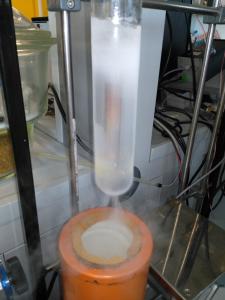Use of Iodine as propellant for Hall Effect Thrusters

A preliminary investigation on iodine as propellant for Hall effect thrusters
Iodine as a propellant is considered a valid alternative to xenon for electric propulsion application, in particular on Hall effect thrusters. Several advantages when using iodine as opposed to xenon can be enumerated. Iodine and xenon atomic mass and first ionization energy are very close and thruster performances, in terms of thrust density, thrust efficiency and specific impulse, have proved to be almost the same. Iodine is solid at ambient temperature and pressure, with a density about four times the density of xenon stored at 200 bar of pressure and ambient temperature. Hence, the same the thrust mission, iodine requires for storage a smaller, not pressurized tank with respect to xenon. Gaseous iodine at low pressure (up to about 10 kPa) can be obtained by heating the solid propellant at relatively low temperature (up to about 100 ?C). Iodine cost is currently 1/15 the cost of xenon and its availability can be considered unlimited for the proposed applications. The iodine condensability potentially reduces pumping requirements in vacuum facilities for on ground testing, yielding a cut in the development costs of the thrusters. However, many issues remain to be assessed before iodine can be widely adopted in space missions. Being a halogen, iodine is chemically active and is not compatible with several materials. Its tendency to condensate on surfaces implies a careful design of the propellant feeding line and thruster injection system, including the cathode. Moreover, spacecraft/plume interaction with the risks of iodine surface deposition and chemical aggression represents a critical issue to be thoroughly investigated. The following tasks are included: 1) Design and manufacture a prototype of iodine feeding system (tank, heaters, valves, throttling and metering system), suitable for an existing, xenon fed, 100 W class Hall effect thruster, including the cathode. 2) Experimental assessment of the feeding system performances in terms of mass flow rate production and controllability. 3) Review and modify the design of the Hall effect thruster and the cathode, to be compatible for iodine operation (materials, injection systems, etc.) 4) Manufacture the modified thruster. 5) Integration of the thruster with the feeding system. 6) Test of the iodine fed thruster, aimed at a first experimental assessment of the operation and the performance of the propulsion system.
